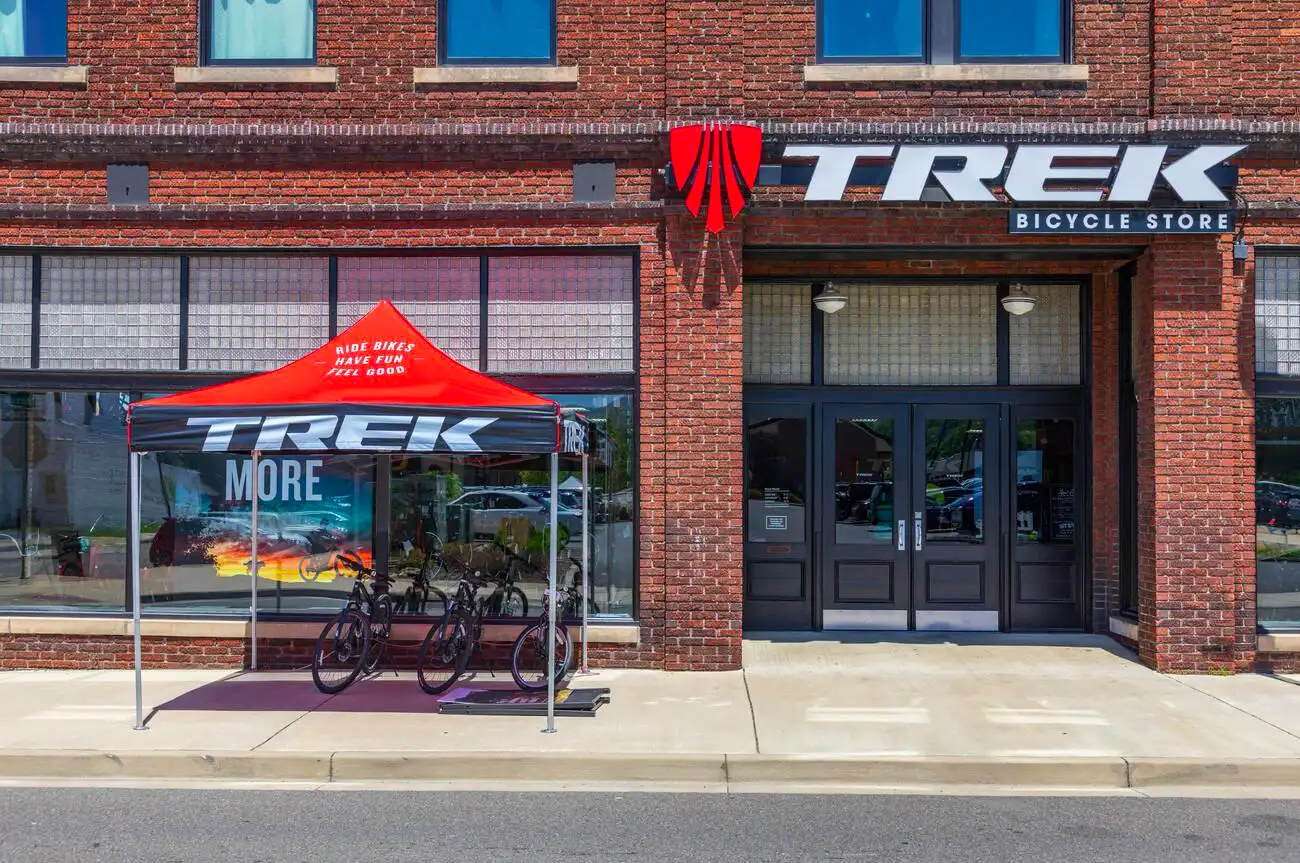
I don’t know about you, but I’m always curious to learn where my bikes and gear are made.
As cyclists, we like to nerd out over not just riding bikes, but how they’re designed and manufactured.
And if you’re like me, you probably ride or dream about riding a Trek at some point.
But where exactly are Trek bikes made? Have manufacturing operations stayed in the USA or moved overseas?
I decided to really dive into the details on where Trek frames and bikes are produced.
In this in-depth article, I’ll share everything I uncovered about Trek’s manufacturing processes and locations over the years.
There’s some fascinating history and details here!
Before we get into current manufacturing, let’s do a quick recap of how Trek Bicycle Corp began.
Trek’s roots trace back to 1976 when it was founded in Waterloo, Wisconsin by Dick Burke and Bevil Hogg.
In the early years, Trek only had a handful of employees building steel-framed touring bikes.
But by the 1980s and 90s, Trek shifted into high-performance road bikes and mountain bikes.
Trek broke into the mainstream with iconic models like the Trek 970 hardtail MTB.
Their bikes were ridden to Tour de France victories and Olympic gold medals.
Brands like Gary Fisher mountain bikes were also acquired.
Today Trek is one of the largest bike makers in the world.
They produce around 1.5 million bikes globally per year across their factories.
Their flagship location is still in Waterloo, Wisconsin.
Okay, now that we’ve covered some Trek history, let’s get into where current production takes place.
Trek has expanded from its roots in Waterloo, Wisconsin to become a global operation.
But where exactly are Trek bikes manufactured today?
Trek’s Global Factories:
So in summary, Trek now produces bicycles in multiple countries spanning North America, Europe, and Asia.
But the heart of their manufacturing is still in the USA at the Waterloo HQ.
Waterloo, Wisconsin – This is where Trek got its start back in 1976.
The Waterloo factory employs over 1,000 American workers today churning out around 1,000 high-end bikes daily.
Trek Waterloo occupies over 950,000 square feet.
It’s here that Trek produces their top-tier road, mountain, electric, and kids bikes to this day.
Germany – Trek has a secondary factory in Germany that handles distribution for the European market.
Some assembly and paint operations take place in Germany.
Holland – Trek’s facility in Holland focuses on research and design.
Prototypes are built here to test new concepts before mass production.
Taiwan – Trek’s Asian factory is located in Taiwan and operated by manufacturing partner Giant.
Carbon frame production and more affordable alloy bike assembly takes place here.
So in summary, while Trek has expanded globally, Waterloo is still the mothership producing Trek’s flagship bikes.
Overseas production handles more affordable models and meets international demand.
A common question I get is whether Trek frames are made in Taiwan.
The answer is yes – many of Trek’s alloy and carbon fiber frames are produced in Taiwan.
Giant Manufacturing, a major Taiwanese bicycle company, is contracted to produce frames for some Trek bike models in their Taiwan factories.
For example, many of Trek’s entry-level and mid-range road and mountain bikes have frames manufactured by Giant.
This includes bikes like:
Producing frames with Giant in Taiwan allows Trek to control costs while still getting high-quality frames.
Labor and manufacturing in Taiwan are generally cheaper compared to the United States.
However, Trek’s top-end road and mountain bikes are still handmade in Waterloo, Wisconsin.
High-performance models like the Madone, Emonda, and Session are all labeled “handbuilt in the USA.”
So in general:
This allows Trek to balance cost control and prestige through a mix of international and domestic production.
With so much manufacturing outsourced, you might wonder: does Trek still make bikes in the United States?
The answer is yes.
While production has expanded globally, Trek Waterloo is still highly active with US bike manufacturing.
Some of Trek’s highest-end road, mountain, and electric bikes are still made completely in Waterloo.
For example, the popular Domane SLR, Madone SLR, and Emonda SLR road bikes are made entirely in Waterloo from design to final assembly.
High-end MTB models like the Session, Fuel EX 9.9, and Remedy 9.9 are also labeled “handbuilt in USA.”
Trek also announced in 2019 that US manufacturing will include electric bikes.
The Trek Powerfly eMTB line is now made in Waterloo rather than sourcing motors and batteries from Asia.
So why does Trek still manufacture high-end bikes in the US?
There are a few key reasons Trek maintains US production:
Made-in-USA gives Trek a production and marketing advantage in the high-performance bike segment.
It makes sense the SLR superbikes are carefully crafted by expert welders and technicians in Waterloo.
Trek has been manufacturing bicycles in the United States since they were founded in 1976.
Even with global expansion, they never fully stopped making bikes in the USA.
However, the proportion of bikes made domestically vs overseas has shifted over the years as manufacturing costs increased.
In the early years, almost all Treks were made in Waterloo, Wisconsin.
But by the 1990s and 2000s as Trek grew rapidly, more manufacturing was outsourced to Asia to control costs.
Rather than outright close US production, Waterloo focused more on high-end bikes.
Rise of Asian Production
Trek expanded their overseas facilities in the last 20-30 years, especially partnering with factories in Taiwan.
Trek pioneered the use of oversized aluminum frames which were easier to produce in Taiwan.
By the 2000s, Trek’s Waterloo headquarters centered on carbon fiber bikes, with aluminum and entry-level bikes coming from Asia.
Overseas production allowed Trek to scale and meet demand growth.
So Trek never outright stopped manufacturing in the US.
They simply scaled back and shifted priorities as the bike business became more competitive and globalized.
Reshoring Initiatives
More recently, Trek has talked about “reshoring” certain manufacturing to the US.
Their Waterloo factory produces select high-end alloy frames again along with carbon fiber.
E-bikes are also now made in the US to control quality and intellectual property.
Expanded use of robotics and automation has improved productivity at the Waterloo plant too.
Trek’s story reflects wider trends of globalization, offshoring, and more recently restoring.
It’s a complex manufacturing evolution!
Analyzing where Trek bikes are made was an insightful dive into the nuances of globalized manufacturing.
Here are my big takeaways:
It’s cool to see Trek is still committed to domestic manufacturing, even at smaller volumes.
And their bikes speak for themselves in terms of quality.
Well, that covers my bike nerd deep dive into how Trek bikes are made!
Let me know if you have any other bicycle manufacturing questions. I’m always happy to chat about this stuff with fellow cycling geeks.
Now it’s time to get out and ride!
